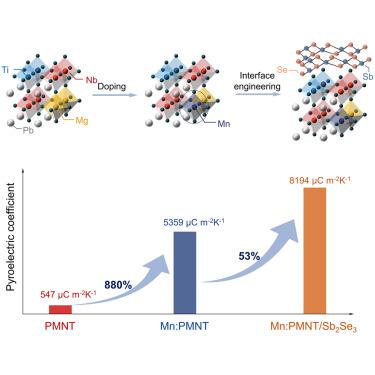Our official English website, www.x-mol.net, welcomes your
feedback! (Note: you will need to create a separate account there.)
Giant pyroelectricity via doping and interface engineering
Joule ( IF 38.6 ) Pub Date : 2024-10-16 , DOI: 10.1016/j.joule.2024.09.009 Chong Guo, Lan Xu, Dingxin Wang, Houbing Huang, Weiqi Qian, Huiyu Dan, Chris R. Bowen, Ya Yang
Joule ( IF 38.6 ) Pub Date : 2024-10-16 , DOI: 10.1016/j.joule.2024.09.009 Chong Guo, Lan Xu, Dingxin Wang, Houbing Huang, Weiqi Qian, Huiyu Dan, Chris R. Bowen, Ya Yang

|
Pyroelectricity plays a crucial role in energy harvesting and sensing. High pyroelectric coefficients are the focus of optimizing pyroelectrics. Elevated pyroelectric coefficients not only contribute to the efficiency of energy conversion and signal resolution to be enhanced but also facilitate device miniaturization and cost reduction. However, the pyroelectric coefficients are typically below 1,000 μC/m²K. Here, we achieve a 14-fold enhancement in the pyroelectric coefficient of 8,194 μC/m²K at room temperature for lead magnesium niobate-lead titanate (PMNT) single crystals. This enhancement can be attributed to a synergistic strategy of doping and interface engineering, which enables the coupling of both intrinsic and interface pyroelectricity. Moreover, doping and interface engineering, respectively, contribute to intrinsic pyroelectricity by altering domain structure and polarization and through interface pyroelectricity by introducing polar symmetry. This synergistic strategy provides a framework to design high-performance pyroelectrics for applications in thermal batteries, infrared sensors, and medical imaging devices.
中文翻译:

通过掺杂和界面工程实现巨型热释电
热释电在能量收集和传感中起着至关重要的作用。高热释电系数是优化热释电体的重点。提高的热释电系数不仅有助于提高能量转换效率和信号分辨率,还有助于器件小型化和降低成本。然而,热释电系数通常低于 1,000 μC/m²K。在这里,我们在室温下将铌酸铅-钛酸铅 (PMNT) 单晶的热释电系数提高了 14 倍,为 8,194 μC/m²K。这种增强可以归因于掺杂和界面工程的协同策略,它实现了本征和界面热释电的耦合。此外,掺杂和界面工程分别通过改变畴结构和极化来促进本征热释电,并通过引入极性对称性来通过界面热释电做出贡献。这种协同策略为设计高性能热释电器件提供了一个框架,用于热电池、红外传感器和医疗成像设备中的应用。
更新日期:2024-10-16
中文翻译:

通过掺杂和界面工程实现巨型热释电
热释电在能量收集和传感中起着至关重要的作用。高热释电系数是优化热释电体的重点。提高的热释电系数不仅有助于提高能量转换效率和信号分辨率,还有助于器件小型化和降低成本。然而,热释电系数通常低于 1,000 μC/m²K。在这里,我们在室温下将铌酸铅-钛酸铅 (PMNT) 单晶的热释电系数提高了 14 倍,为 8,194 μC/m²K。这种增强可以归因于掺杂和界面工程的协同策略,它实现了本征和界面热释电的耦合。此外,掺杂和界面工程分别通过改变畴结构和极化来促进本征热释电,并通过引入极性对称性来通过界面热释电做出贡献。这种协同策略为设计高性能热释电器件提供了一个框架,用于热电池、红外传感器和医疗成像设备中的应用。






























 京公网安备 11010802027423号
京公网安备 11010802027423号